I use RhinoCAM. I don't have any way to model the performance of the port in software. I used VituixCAD to calculate the port length and cross section area.I'm curious what software that second image is? Is it CAD or a simulation system?
Instead of doing simulations, I built a prototype of the port. It worked well enough that I proceed to making molds for the fiberglass one. I had some general ideas of the physics at play, but I may also have something in common with the blind squirrel who found a nut?
It is definitely a valid concern. I don't have any concrete guidance, or a fool-proof rule that I can offer someone. I think it is best to use common sense when listening to music/movies at high levels. I also think it is best when designing a system to err on the side of having more woofer Vd than you think you need. This is not a place to save money and go cheap, and it is not a place to run the performance up to the edge of failure.I listen to a lot of music that i am afraid to use sealed with the LT transform, unless a high-pass filter is also used.
In four years, I have never reached the limit of my woofers. They are SB34NRX75-6, one per side, sealed box, with 8 dB of shelf EQ at ~ 30 Hz. I have a big room and I listen loud, but not nightclub/disco loud. I also sit rather close. One of the most punishing tracks I listen to is the movie "Interstellar" on Blue Ray at theater level. I have watched the woofers during the most bass intensive parts and I believe I am getting about an inch of excursion peak to peak. I am probably going past Xmax, but not getting near the mechanical excursion limit. I have never come close to that while listening to music, even pipe organ.
I almost always use a simple 1st order HP or param EQ with LT.
The penalty in group delay is very small (even less so for a param EQ) and slight difference in -3dB and -12dB point is not really noticeable.
Not only protects the speaker, but also the amplifier.
For when I design real consumer products, I sometimes even add a last resort limiter/compressor.
There is always that one costumer that doesn't understand to not turn certain systems at full blast rave volume for hours on end.
There is a reason PA speakers were invented for that purpose.
Very different design goals.
The penalty in group delay is very small (even less so for a param EQ) and slight difference in -3dB and -12dB point is not really noticeable.
Not only protects the speaker, but also the amplifier.
For when I design real consumer products, I sometimes even add a last resort limiter/compressor.
There is always that one costumer that doesn't understand to not turn certain systems at full blast rave volume for hours on end.
There is a reason PA speakers were invented for that purpose.
Very different design goals.
Last edited:
btw, to actually answer the TS question.
Especially for active systems, sealed systems are actually rather getting back again.
DSP's and power amplifiers are cheap and easy these days plus there plenty of great woofers with enough cone excursion.
It's a great way to get a lot out of a very small box
Something that is just not possible with a ported system because of the super long ports.
Especially for active systems, sealed systems are actually rather getting back again.
DSP's and power amplifiers are cheap and easy these days plus there plenty of great woofers with enough cone excursion.
It's a great way to get a lot out of a very small box
Something that is just not possible with a ported system because of the super long ports.
I'm going to jump in here and ask a few questions as I've been designing up some large floor standing speakers, @hifijim has been a great help answering numerous questions as I'm a bit of a noobie to the technical side of all this.
Sorry if this is sidetracking the thread, but its relevant to my current position.
My floor stander was originally designed around @hifijim 3 way active build, but the 12" Driver I could purchase was diffferent to the one he used, which was the SB34NRXL75-8, which he used in his examples on the previous page of this post. So slightly different specs.
I decided on sealed and running a Linkwitz-transform to bring up the low end as I'm running Hypex amps for an active crossover.
But on this topic, building a high end floor stander, active DSP, beryllium tweeter, textreme mid, SB34NRXL75-8 12" bass driver, should I be
going sealed or ported? I've got between 70-100 Litres I can play with.
I've got an 18" sub covering home theater duties, but i'm aiming for these speakers to be high end for music duties mainly.
What Is the deciding factor when making this decision in my scenario, Ported or Sealed?
I'm right at the point in construction where I can easily make the changes, I guess I just get more confused the more I read and don't want to be unhappy with my decision.
Thanks
Sorry if this is sidetracking the thread, but its relevant to my current position.
My floor stander was originally designed around @hifijim 3 way active build, but the 12" Driver I could purchase was diffferent to the one he used, which was the SB34NRXL75-8, which he used in his examples on the previous page of this post. So slightly different specs.
I decided on sealed and running a Linkwitz-transform to bring up the low end as I'm running Hypex amps for an active crossover.
But on this topic, building a high end floor stander, active DSP, beryllium tweeter, textreme mid, SB34NRXL75-8 12" bass driver, should I be
going sealed or ported? I've got between 70-100 Litres I can play with.
I've got an 18" sub covering home theater duties, but i'm aiming for these speakers to be high end for music duties mainly.
What Is the deciding factor when making this decision in my scenario, Ported or Sealed?
I'm right at the point in construction where I can easily make the changes, I guess I just get more confused the more I read and don't want to be unhappy with my decision.
Thanks
Group delay is potentially audible.What mechanism in EQ-ing a sealed enclosure causes it to mimic the stored energy of a ported speaker's Helmholtz resonator, and consequential long decay times to a step response.

I was only enquiring whether you had an objection to making it leaky.You don't think a wood box can be made air tight. I disagree.
What Is the deciding factor when making this decision in my scenario, Ported or Sealed?
You are the deciding factor.
Porting just extends low frequency response. Do you need that? Only you can decide.
Ok thanks for that @fredygump.
I can do some work in the DSP to get similar results which will be fine for what i'm doing.
Thanks
I can do some work in the DSP to get similar results which will be fine for what i'm doing.
Thanks
"Ported extends low end response" is IMO wrong statement. It gives higher spl above tuning F, but below tuning spl drops down faster. Then add port resonances etc. nonlinearities as extra problems that don't appear on simulations.
Sealed woofer should not have too large box volume, because adequate pressure compression protects from over-excursion. It affects max spl naturally too (power/dynamic compression). BR woofers can be easily get broken with vinyl player's 15Hz or movie 30Hz rumbles and sine wave sweep tests at high spl, because below tuning there won't be pressurization in the chamber.
With sealed woofers and dsp it's safer to use peak correction at ~40Hz instead of shelf (Linkwitz transform) However, in real life and normal size domestic rooms, room modes and pressurization have enormous effect, I don't eq my sealed woofers low end based on nearfield, bur listening spot measurements.
Here my AINOgradient's latest PEQ settings of the woofer, and some measurements. All done in-room so I don't show impulse, decay, distortion etc.
Sealed woofer is SEAS L26ROY in 30 liters, some stuffing. Downfire against the foor and nearness of front wall give some boost. XO around 150Hz acoustic LR2 to dipole 12" mid.
Thread https://www.diyaudio.com/community/threads/aino-gradient-a-collaborative-speaker-project.231353/

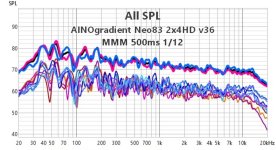
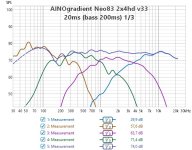
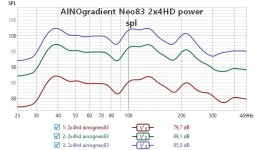
Sealed woofer should not have too large box volume, because adequate pressure compression protects from over-excursion. It affects max spl naturally too (power/dynamic compression). BR woofers can be easily get broken with vinyl player's 15Hz or movie 30Hz rumbles and sine wave sweep tests at high spl, because below tuning there won't be pressurization in the chamber.
With sealed woofers and dsp it's safer to use peak correction at ~40Hz instead of shelf (Linkwitz transform) However, in real life and normal size domestic rooms, room modes and pressurization have enormous effect, I don't eq my sealed woofers low end based on nearfield, bur listening spot measurements.
Here my AINOgradient's latest PEQ settings of the woofer, and some measurements. All done in-room so I don't show impulse, decay, distortion etc.
Sealed woofer is SEAS L26ROY in 30 liters, some stuffing. Downfire against the foor and nearness of front wall give some boost. XO around 150Hz acoustic LR2 to dipole 12" mid.
Thread https://www.diyaudio.com/community/threads/aino-gradient-a-collaborative-speaker-project.231353/



Last edited:
What Is the deciding factor when making this decision in my scenario, Ported or Sealed?
You have bought a nice and pretty expensive driver that has parameters optimized for a modest sized ported box typical of studio monitors. The cheaper SB 12" has parameters better suited to large sealed cabinets.
For a largish 3 way a ported cabinet has several significant advantages and only minor disadvantages. Despite the chat in this thread in use in a typical room a ported 12" woofer will almost certainly have no audible defects listening to music compared to a sealed woofer but will likely have advantages unless they are high passed for subs or the levels are low.
Enthusiasts have a tendency to strongly weight aspects they are enthusiastic about. Large group delays at low frequencies can be audible but compared to a lack of clean SPL it is a lot less intrusive. Unlike at high frequencies where our pair of ears enable us to distinguish speaker and room at low frequencies we cannot do this because of the long wavelengths compared to the distance between our ears. This means that at low frequencies the lightly damped room resonances tend to dominate our perception rather than the well damped resonance of a sealed speaker or pair of resonances of a ported speaker.
If you intend to always use distributed subs then that could make a reasonable case for putting the woofer in a small sealed cabinet. Another might be if you always listen below standard listening levels. Both usages would somewhat waste the capabilities of the driver though with a more modest 12" being a more balanced choice.
Of course if you place significant value on minimizing group delay then put the woofers in a sealed cabinet and equalize to taste. It's a hobby and following what's of interest is likely to be more fun than following the conventional balance of pros and cons unless taken to extremes.
My L26ROYs han been hanging upside down for 10½ years now. No troubles, but I haven't bothered to check them out. And I can't do T/S measurements.
At least a benefit is that cone's rubber surround is protected from UV! [Perhaps I should connect a 1,5V battery to woofer, at least for night time ... ]
]
https://www.klipsch.com/blog/down-firing-vs-front-firing-subwoofer-comparison-guide
https://blog.teufelaudio.com/front-and-down-firing-subwoofers/
By the way, I've seen a recommendation that vertically mounted heavy (Mms) woofers should be rotated regularly, to prevent coil contact to magnet
About higher distortion of sealed woofers below say 60Hz, harmonic low order 10-30% distortion only makes bass sound louder. In isolated sine wave test one could perhaps identify distortion. Actually this distortion adds also feeling of attack, as we can read from studio nerd's guides that I linked earlier.

At least a benefit is that cone's rubber surround is protected from UV! [Perhaps I should connect a 1,5V battery to woofer, at least for night time ...
https://www.klipsch.com/blog/down-firing-vs-front-firing-subwoofer-comparison-guide
https://blog.teufelaudio.com/front-and-down-firing-subwoofers/
By the way, I've seen a recommendation that vertically mounted heavy (Mms) woofers should be rotated regularly, to prevent coil contact to magnet
About higher distortion of sealed woofers below say 60Hz, harmonic low order 10-30% distortion only makes bass sound louder. In isolated sine wave test one could perhaps identify distortion. Actually this distortion adds also feeling of attack, as we can read from studio nerd's guides that I linked earlier.
Last edited:
Exactly. Besides that, most has been said apart from things about thermal compression and the practical limits on EQ-ing a closed system. A lot of bass systems distort quite heavily on large excursions and the trouble is these distortions are very audible because of our hearing.Enthusiasts have a tendency to strongly weight aspects they are enthusiastic about. Large group delays at low frequencies can be audible but compared to a lack of clean SPL it is a lot less intrusive.
Drivers are quite complex systems being both electrical and mechanical. Many parameters change with voice coil position, and are non-linear, thus any "DC offset" to voice coil position affects distortion somehow. If suspension is stiff and cone relatively light, I'd assume it doesn't offset that much. But there is more 
Rest position depends on suspension stiffness, and if positioned horizontal also from weight. When in use electrical parameters can also cause bias, for example force factpr can be more on other direction than the other, certainly with high excursion.
I simplify my thought by thinking transistor operation, where bias current is used to set operating point so that both positive and negative swing start clipping same time to get max headroom. A voice coil has rpughly two, motor and suspension, which might need to be biased to positive or negative direction, or opposing directions. Thus, dependong on driver mounting it horizontal might make it better biased, or worse biased, it could be benign or quite bad difference no mater which way. Basically it all depends on the driver, and how much there is clean headroom to waste and so on answer is, perhaps it doesn't matter, if in doubt try and measure.
answer is, perhaps it doesn't matter, if in doubt try and measure.
example klippel data here:
https://audioxpress.com/article/voi...cor-s-new-sw259wa01-10-25-high-xmax-subwoofer
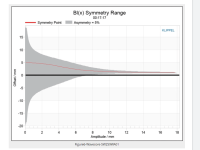
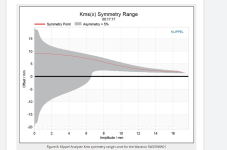
Both suspension stiffness Kms(x) and motor force Bl(x) are biased positive, which I think means the voice coil is naturally biased bit outward. If this driver was put cone toward floor it would make bit more distortion than regular vertical orientation. If cone was toward ceiling it would make bit less distortion. How much? I've got no idea. Notice how the symmetry changes with excursion and so on, so it's quite complex. I think best would be to listen and measure, if performance is significantly worse in horizontal orientation than vertical, perhaps consider another driver.
Rest position depends on suspension stiffness, and if positioned horizontal also from weight. When in use electrical parameters can also cause bias, for example force factpr can be more on other direction than the other, certainly with high excursion.
I simplify my thought by thinking transistor operation, where bias current is used to set operating point so that both positive and negative swing start clipping same time to get max headroom. A voice coil has rpughly two, motor and suspension, which might need to be biased to positive or negative direction, or opposing directions. Thus, dependong on driver mounting it horizontal might make it better biased, or worse biased, it could be benign or quite bad difference no mater which way. Basically it all depends on the driver, and how much there is clean headroom to waste and so on
example klippel data here:
https://audioxpress.com/article/voi...cor-s-new-sw259wa01-10-25-high-xmax-subwoofer


Both suspension stiffness Kms(x) and motor force Bl(x) are biased positive, which I think means the voice coil is naturally biased bit outward. If this driver was put cone toward floor it would make bit more distortion than regular vertical orientation. If cone was toward ceiling it would make bit less distortion. How much? I've got no idea. Notice how the symmetry changes with excursion and so on, so it's quite complex. I think best would be to listen and measure, if performance is significantly worse in horizontal orientation than vertical, perhaps consider another driver.
Last edited:
Distortion at lower frequencies is actually very difficult to hear?Exactly. Besides that, most has been said apart from things about thermal compression and the practical limits on EQ-ing a closed system. A lot of bass systems distort quite heavily on large excursions and the trouble is these distortions are very audible because of our hearing.
I still really think that the part that gets basically no attention, is the huge shift in BL and a little bit Fs by the non-linear BL(x) and Cms(x).
I am not talking distortion, just system response.
With these both around 10%-20%, there is nothing left of that response anymore.
This problem is far more significant for ported systems.
That comparison with a transistor isn't bad btwDrivers are quite complex systems being both electrical and mechanical. Many parameters change with voice coil position, and are non-linear, thus any "DC offset" to voice coil position affects distortion somehow. If suspension is stiff and cone relatively light, I'd assume it doesn't offset that much. But there is more
Rest position depends on suspension stiffness, and if positioned horizontal also from weight. When in use electrical parameters can also cause bias, for example force factpr can be more on other direction than the other, certainly with high excursion.
I simplify my thought by thinking transistor operation, where bias current is used to set operating point so that both positive and negative swing start clipping same time to get max headroom. A voice coil has rpughly two, motor and suspension, which might need to be biased to positive or negative direction, or opposing directions. Thus, dependong on driver mounting it horizontal might make it better biased, or worse biased, it could be benign or quite bad difference no mater which way. Basically it all depends on the driver, and how much there is clean headroom to waste and so onanswer is, perhaps it doesn't matter, if in doubt try and measure.
example klippel data here:
https://audioxpress.com/article/voi...cor-s-new-sw259wa01-10-25-high-xmax-subwoofer
View attachment 1311189 View attachment 1311190
Both suspension stiffness Kms(x) and motor force Bl(x) are biased positive, which I think means the voice coil is naturally biased bit outward. If this driver was put cone toward floor it would make bit more distortion than regular vertical orientation. If cone was toward ceiling it would make bit less distortion. How much? I've got no idea. Notice how the symmetry changes with excursion and so on, so it's quite complex. I think best would be to listen and measure, if performance is significantly worse in horizontal orientation than vertical, perhaps consider another driver.
Also immediately shows the limitations of a very well performing smaller woofer.
It's great, but it's basically the same as a well performing 15W amplifier.
Meaning there isn't that much headroom.
The voltage rails can be seen as the max excursion.
Anyway, I invested in a laser displacement sensor and came across a paper/thesis of some who actually investigated if a speaker with a DC offset could be improved while facing it up or down. I will try to find it again.
But yeah, in general it's not a great idea.
Especially for those people who like to put a lot of attention and detail in lowest distortion.
Err, I don't follow you. If a LF speaker distorts 10% H2 at 30Hz, the percepted H2 is only 5dB under the base frequency. If the H3 would be 10%, it actually would be louder than the 30Hz. But you know that. It actually is a well-used phenomenon in small speaker design. There seems to be bass, but there isn't.Distortion at lower frequencies is actually very difficult to hear?
- Home
- Loudspeakers
- Multi-Way
- Why are sealed box woofers out of fashion